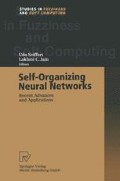Abstract
An introduction to and overview of the Self-Organizing Map (SOM) methods is presented in this chapter.
Access this chapter
Tax calculation will be finalised at checkout
Purchases are for personal use only
Preview
Unable to display preview. Download preview PDF.
Bibliography on Chapter 1
Kohonen, T. (1982) Self-organizing formation of topologically correct feature maps. Biol. Cybern. 43, 59–69
Kohonen, T. (1982) Clustering, taxonomy, and topological maps of patterns. Proc. 6th Int. Conf. Pattern Recognition, Munich, Germany, 114–128
Kohonen, T. (2001) Self-Organizing Maps, 3rd ed. Springer, London
Young, G., Householder, A. S. (1938) Discussion of a set of points in terms of their mutual distances. Psychometrika 3, 19–22
Kruskal, J. B., Wish, M. (1978) Multidimensional Scaling. Sage University Paper Series on Quantitative Applications in the Social Sciences No. 07–011. Sage Publications, Newbury Park
Ultsch, A., Siemon, H. (1989) Exploratory Data Analysis: Using Kohonen’s Topology Preserving Maps. Technical Report 329. Univ. of Dortmund, Dortmund, Germany
Kraaijveld, M. A., Mao, J., Jain, A. K. (1992) A non-linear projection method based on Kohonen’s topology preserving maps. Proc. 11ICPR, Int. Conf. on Pattern Recognition. IEEE Comput. Soc. Press, Los Alamitos, CA, 41–45. Also IEEE Trans. on Neural Networks 6, 548–559 (1995)
Cottrell, M., Fort, J. C., Pagés, G. (1997) Theoretical aspects of the SOM algorithm. Proc. WSOM’97, Workshop on Self-Organizing Maps. Helsinki University of Technology, Neural Networks Research Centre, Espoo, Finland, 246–267
Cheng, Y. (1997) Convergence and ordering of Kohonen’s batch map. Neural Computation 9, 1667–1676
Cottrell, M., Fort, J.-C. (1987) Étude d’un processus d’auto-organisation. Annales de l’Institut Henri Poincaré 23, 1–20
Flanagan, J. A. (1994) Self-Organizing Neural Networks. Ph.D. Thesis, Swiss Federal Inst. of Tech. Lausanne (EPFL )
Ritter, H., Martinetz, T., Schulten, K. (1992) Neural Computation and Self-Organizing Maps: An Introduction. Addison-Wesley, Reading, MA
Heskes, T. (1993) Guaranteed convergence of learning rules. Proc. Int. Conf. on Artificial Neural Networks (ICANN’93), Amsterdam, The Netherlands, 533–536
Heskes, T. and Kappen, B. (1993) Error potential for self-organization. Proc. Int. Conf. Neural Networks (ICNN’93), vol. III, 1219–1223
Luttrell, S. R. (1992) Code Vector Density in Topographic Mappings. Memorandum 4669. Defense Research Agency, Malvern, UK
Zrehen, S. (1993) Analyzing Kohonen maps with geometry. Proc. Int. Conf. on Artificial Neural Networks (ICANN’93), Amsterdam, The Netherlands, 609–612
Villmann, T., Der, R., Martinetz, T. (1994) A new quantitative measure of topology preservation in Kohonen’s feature maps. Proc. IEEE Int. Conf. on Neural Networks (ICNN’94), 645–648
Kiviluoto, K. (1996) Topology preservation in self-organizing maps. Proc. IEEE Int. Conf. on Neural Networks (ICNN’96), 294–299
Kaski, S., Lagus, K. (1996) Comparing self-organizing maps. Proc. Int. Conf. on Artificial Neural Networks (ICANN’96), 809–814
Ritter, H. (1991) Asymptotic level density for a class of vector quantization processes. IEEE Trans. Neural Networks 2, 173–175
Kohonen, T. (1999) Comparison of SOM point densities based on different criteria. Neural Computation 11, 2081–2095
Gersho, A. (1979) Asymptotically optimal block quantization. IEEE Trans. Inform. Theory IT-25, 373–380
Zador, P. (1982) Asymptotic quantization error of continuous signals and the quantization dimension. IEEE Trans. Inform. Theory IT-28, 139–149
Kohonen, T. (1998) Computation of VQ and SOM Point Densities Using the Calculus of Variations. Report A52, Helsinki University of Technology, Laboratory of Computer and Information Science, Espoo, Finland.
Kohonen, T., Kaski, S., Lagus, K., Salojärvi, J., Honkela., J., Paatero, V., Saarela, A. (2000) Self-organization of a massive document collection. IEEE Trans. Neural Networks 11, 574–585
Kohonen, T. (1993) Physiological interpretation of the self-organizing map algorithm. Neural Networks 6, 895–905
Kaski, S., Kangas, J., Kohonen, T. (1998) Bibliography of self-organizing map (SOM) papers: 1981–1997. Neural Computing Surveys 1, 1–176 (http://www.icsi.berkeley.edurjagota/NCS/)
Alhoniemi, E., Hollmén, J., Simula, O., Vesanto, J. (1999) Process monitoring and modeling using the self-organizing map. Integrated Computer-Aided Engineering 6, 3–14
Deboeck, G., Kohonen T. (Eds.) (1998) Visual Exploration in Finance with Self-Organizing Maps. Springer, London (Japanese translation: Springer, Tokyo, 1999 )
Naim, A., Ratnatunga, K. U., Griffiths, R. E. (1997) Galaxy morphology without classification: self-organizing maps. Astrophys. J. Suppl. Series 111, 357–367
Miikkulainen, R. (1993) Subsymbolic Natural Language Processing: An Integrated Model of Scripts, Lexicon, and Memory. MIT Press, Cambridge
Tokutaka, H., Kishida, S., Fujimura, K. (1999) Applications of Self-Organizing Maps. Kaibundo, Tokyo, Japan (in Japanese)
van Hulle, M. M. (2000) Faithful Representations and Topographic Maps — From Distortion-to Information-Based Self-Organization. John Wiley, New York
Oja, E., Kaski, S. (Eds.) (1999) Kohonen Maps. Elsevier, Amsterdam
Neurocomputing 21, Special issue on self-organizing maps, Nos. 1–3, October 1998
Editor information
Editors and Affiliations
Rights and permissions
Copyright information
© 2002 Springer-Verlag Berlin Heidelberg
About this chapter
Cite this chapter
Kohonen, T. (2002). Overture. In: Seiffert, U., Jain, L.C. (eds) Self-Organizing Neural Networks. Studies in Fuzziness and Soft Computing, vol 78. Physica, Heidelberg. https://doi.org/10.1007/978-3-7908-1810-9_1
Download citation
DOI: https://doi.org/10.1007/978-3-7908-1810-9_1
Publisher Name: Physica, Heidelberg
Print ISBN: 978-3-662-00343-5
Online ISBN: 978-3-7908-1810-9
eBook Packages: Springer Book Archive

